Tool/software:
Hi AE,
I have a few questions regarding the TS3A27518E.
- Can this MUX support SPI 66MHz?
- What is the propagation delay between NC and COM (or NO and COM)
Best Regards
This thread has been locked.
If you have a related question, please click the "Ask a related question" button in the top right corner. The newly created question will be automatically linked to this question.
Tool/software:
Hi AE,
I have a few questions regarding the TS3A27518E.
Best Regards
Hi Bruce
1.This device can support a 66MHz SPI signal with its bandwidth being 240MHz( 3x times the signal frequency)
This app note talks about selecting a multiplexer based on bandwidth and the performance of this device will look similar to the second set of images on this picture

2.The propagation delay of analog multiplexers is actually load dependent so the load connected to the multiplexer will be the determining factor of propagation delay in a design.
I would actually recommended the customer to read this FAQ to understand this topic and greater detail and be able to estimate the actual propagation delay in the design
Please let me know what you think about this information and we can continue to discuss.
Regards,
Kameron
Hi AE,
The data continuous 66 MHz clock (T = 15 ns) is input, and the first High pulse (15 ns) goes in, but the switch requires 50 ns ton to respond,
During the 50 ns response time, will the second Low or High signal be missed?


Best Regards
Hi Bruce
Thank for this extra information and I can help you more with this
The Ton and Toff specs actually do not matter in respects to the actual signal passing through the multiplexer
a 66MHz signal( T=15ns) is fine.
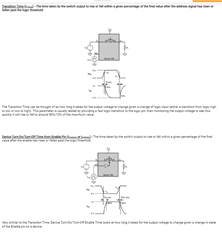
Ton and Toff is simply the amount of time it takes for the input signal to be seen at the output signal after a the switch path has been turned off or on with the control logic.( This has nothing to do with the actual signal passing through the mux
https://www.ti.com/video/6112999832001
Check out this links to learn more
Regards,
Kameron
Hi AE,
Please kindly confirm whether the calculation method is correct.
The Tdp calculation method is summarized as follows.
1. Tdp = Tdp on + Tdp off
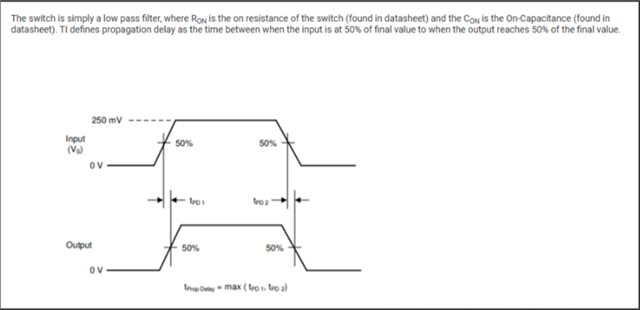
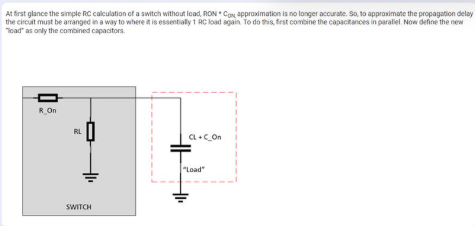

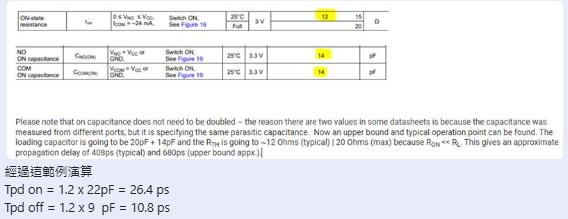
Hi Robin and Bruce
Apologies for the delay as I was OoO for the last few days
So just to clarify
Propagation delay is actually the delay between the signal on the input pin passing though the device and showing up on the output pin( Propagation delay is measured when the switch is on or closed ) Another way to say it is propagation delay is how long it takes for the input signal on a on channel to show up on the corresponding output pin it is connected too.
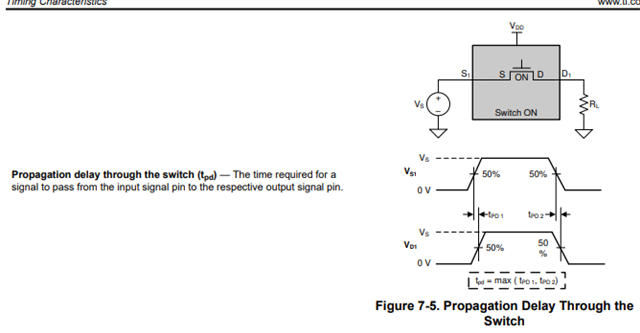
So if we look at the TS3A27518E at 1.8V supply then we get a typical ron of 7.1 ohms and con typical of 22pf


Tpd= ~ 7.1 x 22= 156.2 ps ( This is the approximate propagation delay for the switch path alone and in most applications prop delay is mostly load dependent and can be accounted for if added into the calculation according to the FAQ i sent earlier)
Also just to reiterate prop delay is measured when the switch path is closed/on.
off propagation delay isn't something measured by our team because when the switch path is open/off the path is high impedance meaning signals should not pass through the device.
Please let me know if this helps and I can explain further if needed.
Regards,
Kameron